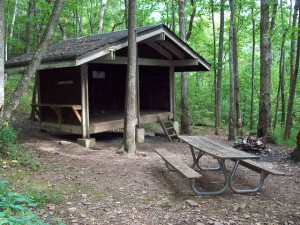Just 40 miles north of Atlanta, outdoor enthusiasts can begin edging into mountain country; rocky balds, wooded mountainsides, and endless hollows. Visualize a place where hikers can pitch a tent on a mountain top and get a front row seat to both a sunset and a sunrise.
Georgia’s Appalachian Trail
The Georgia section of the Appalachian Trail, or AT, starts at its most southern point just eight miles north of Amiacalola Falls State Park in the Chattahoochie National Forest at Springer Mountain, and stretches 75 miles to Bly Gap on the Georgia/South Carolina border. The trail extends approximately 2,175 miles along the eastern ridge to Mt. Katahdin, Maine.
The AT in Georgia is maintained by the Georgia Appalachian Trail Club. The GATC has done an excellent job of maintaining the trail and the 12 shelters that lie along this section of trail. Almost all of the shelters are located near water sources with the exception of one located on Blood Mountain.
Getting to the trail is relatively easy. due to the numerous trail heads located along the AT. One such place is Unicoi Gap, located just north of Helen, Georgia. Other popular trail heads include Woody Gap, Tesnatee Gap, and Neel’s Gap. A complete listing can be found on the GATC’s website, which maintains information about the trail, along with detailed maps, trail, and water reports.
Terrain, Weather, and Wildlife
For beginning hikers, the terrain in Georgia can be strenuous, complete with numerous ascents and descents ranging between 2500 and 4400 feet. Care should be taken during all aspects of the hike on this rugged, rocky terrain. This is a good place to incorporate the use of trekking poles and to use the buddy system. Invest in a good pair of hiking boots and practice proper foot care.
Mountain weather in Georgia should never be underestimated. Freezing temperatures can occur from early fall to late spring. Georgia has also been known to receive heavy rainfall amounts, so hikers should be aware and carefully research weather conditions before starting out.
Hikers are sometimes fortunate enough to catch a glimpse of some of the wildlife along the trail. Although black bear do inhabit the region, they tend to avoid hikers and campers. It’s more common to see white-tailed deer, chipmunks, and eagles along the trail. Serious wildlife spotters may even be able to spot the rare Appalachian Salamander.
Georgia’s AT Highlights
The most popular hiking hot spot along the Georgia portion of the AT has to be Neel’s Gap, located at the base of Blood Mountain. It boasts the only business actually located on the 2,175 mile trail. Neel’s Gap hosts a hiking store, laundry, and a hostel for weary hikers. The hostel fills up quickly in the spring and is available on a first-come/first-serve basis. Contact Mountain Crossings for information on hostel fees at the Walasiyi-Inn.
Blood Mountain is a notable must-see along the trail. At 4,458 feet, Blood Mountain gets its name from a fierce battle that ensued between the Creek and Cherokee Indians. At the top of this mountain lies a stone shelter where tired hikers are rewarded with incredible views. If thinking about a trip to Georgia’s AT, be sure to include this on the next hike.
This article is copyrighted by Beverly Hill
[amazon template=iframe image&asin=B014QB6SZ4]





I’ve hiked here and there on the Georgia section of the AT a few times, and it’s always nice. While Florida does have some great hikes, I still love getting on trails that have a little elevation! The approach trail from Amicalola up to Springer Mountain is a great taste of the AT.
I just got back from Alabama, where I did a little exploring on the Pinhoti Trail, another trail I’d like to spend some time on. Might hike this one before too long!